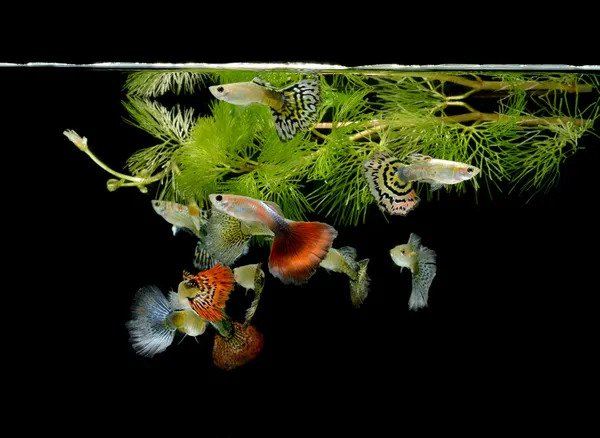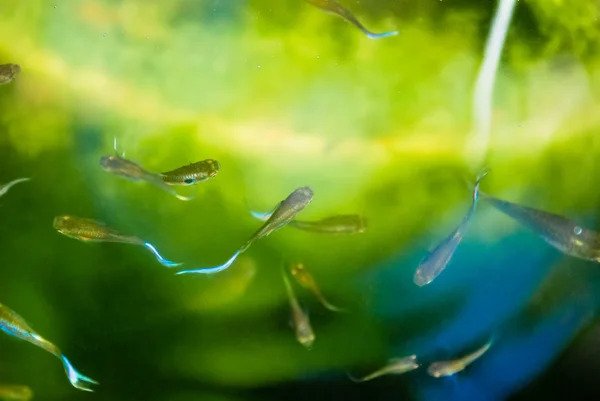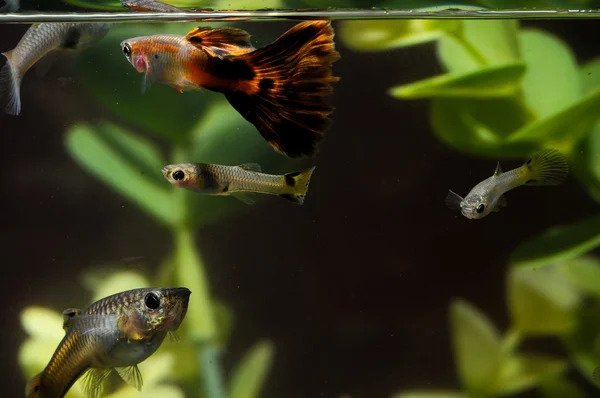Guppies reproduce at a very fast rate, giving birth to several baby guppies in the aquarium. They are prolific at reproducing a large number of offspring.
If care is not taken, they can overcrowd your aquarium. This is why newbies in the hobby may wonder whether guppies breed by laying eggs or birthing live young ones and how to handle population control in aquariums.
Here is the a-z every fish hobbyist must know about guppies.
Do Guppies Lay Eggs?

The answer is no. Guppies are livebearers. Unlike many fish species, which are egg layers, guppies give birth to live guppy fry. The female guppies give birth to live guppy fry because guppies are a livebearer species.
Pregnant female guppies do not lay eggs. Rather, they hold the fertilized eggs in their bodies throughout the gestation period. Depending on many environmental factors, the gestation period can range from 20-60 days at 77°f – 80°f.
After the eggs hatch, the mother guppy expels around d 20-60 free swimming fry from her body.
Female guppies can reproduce all year round, and a mother guppy becomes ready to produce offspring quickly after giving birth to a batch fry.
How Often Can Female Guppies Reproduce
There is a reason guppies are called million fish: a female guppy can experience a gestation period every month, giving live birth to as much as 600 free swimming fry in your aquarium every year!

This can be a problem to control, no matter how big your tank is, especially if your tank has the right water parameters necessary for breeding.
Although these livebearers have a mating ritual for giving birth, female guppies can get pregnant after the initial sexual encounter even without the mating ritual.
Normally, the male guppies make courtship advance toward the female guppies. A female guppy will accept the advances and courtship display of a male guppy by allowing him to insert his gonopodium into her genital pore briefly. This leads to internal fertilization.
However, there are instances where a sneaky male forces copulation with a female guppy. He approaches her unsuspectingly and thrusts his gonopodium into her urogenital pore. So as long as you have male and female guppies in your tank, you will inevitably have pregnant female guppies. It will only be a matter of time before these livebearers overpopulate your tank with fry.
Why Does a Female Guppy Lay Eggs?
Basically, guppies are livebearers. There is no confusion about guppies being livebearers. They do not lay eggs normally.
In fact, it is very rare to see guppies lay eggs. Like many other livebearer species, they normally retain the eggs in their bodies. Guppies reproduce by birthing the live fry inside their bodies.
However, there are times when you may notice some eggs inside the tank. Although this is very rare, there are several reasons for this. Below are three reasons:
Unfertilized Eggs
Sometimes a pregnant guppy may have unfertilized eggs inside her body. Eggs like these are known as dead eggs.
Guppies lay unfertilized eggs because they have to expel them from their bodies to avoid severe health issues.
Whenever you find such eggs in your tank, it would be best to remove them from your tank. They will never hatch into fry inside your aquarium.
Eggs Are Not Formed Properly
Another reason you might find eggs in your guppy tank is if the eggs are not formed properly. There are two main reasons for this. One is poor water quality.
Essentially, the bacteria in the water kills the eggs before the mother guppy has had a chance to birth her fry.
Another reason is stress. When pregnant female guppies come under stress during the gestation period, the eggs guppies carry can become unhealthy.
Guppy Fry Are Not Formed Properly
Although guppies are livebearers, they sometimes give birth to improperly formed fry. When these happen, the fry are usually still inside the eggs.
When pregnant guppy eggs are like these, you may notice that they are big and even see movements inside them. When a pregnant guppy delivers eggs like these, it is important to understand that they are miscarriages.
When delivered by female pregnant guppies, fry from eggs like these are usually not healthy. They can hardly live a normal life in the aquarium like healthy guppies.
Can Female Guppies Give Birth Without Male Guppies?

Sometimes, you may notice that your female guppies continue to produce offspring even after you have expelled the males in the aquarium to check overpopulation. This is another interesting aspect of how guppies reproduce.
After the initial deposit of insemination, female guppies can store sperm for up to 8 months.This means you can keep having pregnant female guppies in your aquarium because the sperm stored in their ovaries and gonoducts can continue to fertilize the eggs inside their bodies for up to 8 months.
This is the main reason female pregnant guppies can continue to give birth to baby guppy fish long after mating with male guppies.
Where Do Guppies Lay Eggs?
Unlike many freshwater fish species that lay eggs, guppies birth their fry live instead of laying eggs inside the aquarium. A pregnant guppy will only lay eggs inside the aquarium when the circumstances are unfavorable.
During pregnancy, female guppies usually explore the aquarium to find a suitable spot in the aquarium for giving birth. A female guppy will do this, especially as her gravid spot grows large and dark enough to signal a possible delivery anytime soon.
Normally, she will lay at the base of the aquarium behind a base rock or plants to birth her healthy guppies. If there are no hiding places in the aquarium, you can expect her to choose a discreet corner of the aquarium to expel all the fry in her.
What Can I Do After My Female Guppies Give Birth?
Although guppies are peaceful fish, one weird habit they have is that they eat their fry. If you are not quick enough to save them, you will end up with just a few fry.
It would be best to separate them before the mature guppies eat them in the aquarium. This is especially urgent if you keep a community tank with a wider range of biodiversity.
You want to separate the fry from the adult guppies in the aquarium. Put the fry in another aquarium with the water temperature at 80°f. Water changes are very important to ensure they do not die from poor water quality.
For feeding, you can start them with flake food. You also introduce them to live food, but you want to pay attention to the size of the food item you are offering them.
Also, the frequency is important. At 80°f, the fry will digest food faster, so you want to feed them about 5-10 times a day.
What Other Fish Are LiveBearers?
Guppies are not the only livebearers in the hobby. Among the freshwater fish species, there are many others who also give birth to their young ones live. Many of them belong to the Poeciliidae family.
They include Platies, Swordtail fish, Endlers, Goodeides, Halfbeaks, Mollies, and many more.
Bottom Line
Guppy fish are livebearers. They do not lay eggs. They birth baby guppies live instead of laying eggs.
When your pregnant guppies birth their live babies, do not expect them to come out as active fry immediately. They are usually born curled. They come out as small balls and start swimming after uncurling themselves. It would be best to separate them from the main aquarium for proper care.
If you want to breed guppies, understanding how the female guppies’ bodies work is crucial, and this article is a good starting point.
Related Reading:
References:
- https://en.wikipedia.org/
- https://www.theaquariumwiki.com/
- https://dnews.com/

